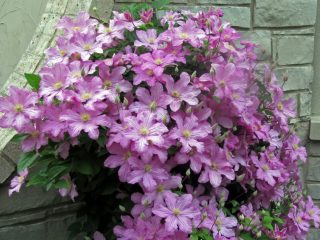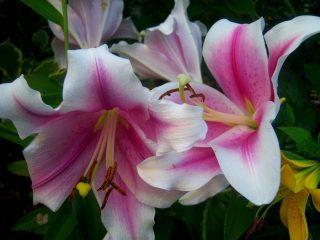Content
Geranium Himalayan Plenum is a popular type of crop with long and generous flowering. The plant does not require special attention during care, feels great in different soils, and has a very stable immunity to disease. Subject to agrotechnical rules, the crop has been pleasing the gardener with its attractive appearance for several years.

Geranium Plenum Himalayan is a herbaceous perennial shrub
History of origin
Geranium Plenum (geranium Plenum) was first discovered in Asia in the highlands; it is also common in forest edges, subalpine and alpine meadows, covers mountain slopes, and is often found in the Himalayas, which is why it was given the second name - Himalayan. It tolerates drought and frost well and thrives in Russia, China, Korea, and the USA. They began to study the species and plant it in garden plots in the mid-19th century.
Description of the Himalayan geranium Plenum with photos
Himalayan geranium is a low, dense bush that usually grows to 30-50 cm.It is distinguished by beautiful five-fingered oval-shaped openwork leaves, the size of which can reach 10 cm. They have a rich green color and expressive purple veins, a pubescent surface, and are located on high petioles (up to 20 cm). Unlike other varieties of geranium, Plenum flowers are large, with a diameter of 3 to 5 cm. They are double, of an ideal symmetrical shape, mostly lilac, purple or blue in color. Located on umbrella-shaped peduncles.
The root system of the plant is powerful and grows quite densely. The thick root can reach 1.5-2 cm in diameter and often appears on the surface of the ground in the summer.
Gardeners usually use Plenum as a ground cover crop, since it can form closed and dense growth in a short time, although it can be planted in any flower beds and mixborders.
Plenum blooms for a long time, begins in May and ends closer to September. The buds do not fade for a long time. It is also worth noting that the variety has a strong and pleasant aroma.

The main decorative qualities of Plenum are elegant flowers and carved leaves
Advantages and disadvantages
Any variety of geranium has a large number of advantages, and the Himalayan Plenum is generally the most popular variety of crop in landscape design.

The type of Himalayan geranium is popularly called grandiflora
Advantages:
- unpretentiousness;
- abundant and long flowering;
- winter hardiness;
- disease resistance;
- a wide variety of varieties.
Flaws:
- demands on light;
- need for pruning.
Planting terry geranium Plenum
Planting Himalayan geraniums should be done in a well-lit area; shading is allowed only for a few hours a day.It is better to locate the Plenum on a hill, since the culture does not respond well to high groundwater levels.
For planting, gardeners usually use seedlings purchased from a specialty store, or obtained from their own plant by dividing the roots. In this case, the material must be healthy and well developed. Before planting in open ground, it should be stored in a cool place in a container with peat.
At the end of spring, when the time comes to plant the Himalayan geranium Plenum, the area where it will grow is dug deep, fertilized with peat or manure and watered. Next, holes are dug at intervals of 25 cm, with a depth greater than the volume of the roots of the seedling by 20 cm. A layer of gravel, expanded clay or broken brick is poured into the bottom of the planting holes, and peat mixed with sand is placed on top. The seedling is placed in the hole, leveling its roots, sprinkled with earth, watered abundantly and covered with a layer of mulch.
Caring for terry geraniums Plenum
Plenum is a variety of Himalayan geranium that does not require special care, but in order for it to show itself in all its glory, you need to take at least a little care of it. It is important to moisten flower beds in a timely manner, especially in the first few weeks after planting, and to fertilize and prune from time to time.
After each watering, it is recommended to loosen the soil and regularly replenish the mulch. Himalayan geranium responds well to feeding. For its lush and long-lasting flowering, it is best to use complex mineral supplements. If you feed Plenum with potassium-phosphorus compounds, this will increase the number of inflorescences on the bush.
For a more elegant look, it is advisable to trim the Himalayan geranium.This should be done at the end of summer. Remove all woody shoots, leaving stumps no larger than 10 cm.
Diseases and pests
Himalayan geranium Plenum can only get sick if it is not cared for properly. Common diseases include rot, which appears on the plant when there is too much moisture, and Fusarium wilt. Rarely, a flower is affected by chlorosis and powdery mildew.
Among the pests, geranium Plenum can be attacked by caterpillars, aphids, spider mites and whiteflies. You need to fight them with the help of folk remedies and chemicals.
Application in landscape design
Terry Himalayan geranium Plenum, the photo of which is presented above, is widely used in landscape design of personal plots due to its unpretentiousness and decorative properties. It is used to decorate rock gardens, borders, alpine slides, decorate ponds, and complement flower arrangements in mixborders and other flower beds. Plenum goes well with other varieties of geraniums, as well as with almost any beautiful flowering plants. Can provide ground cover in areas with cool climates.

Plenum can be planted in pots and flowerpots on the balcony
Conclusion
Geranium Himalayan Plenum is a pretty perennial that is densely covered with double buds for a long time. Planting, growing and caring for a crop does not take much effort and time from the gardener, due to which it has earned increased interest in floriculture.
Reviews of Himalayan geranium Plenum








